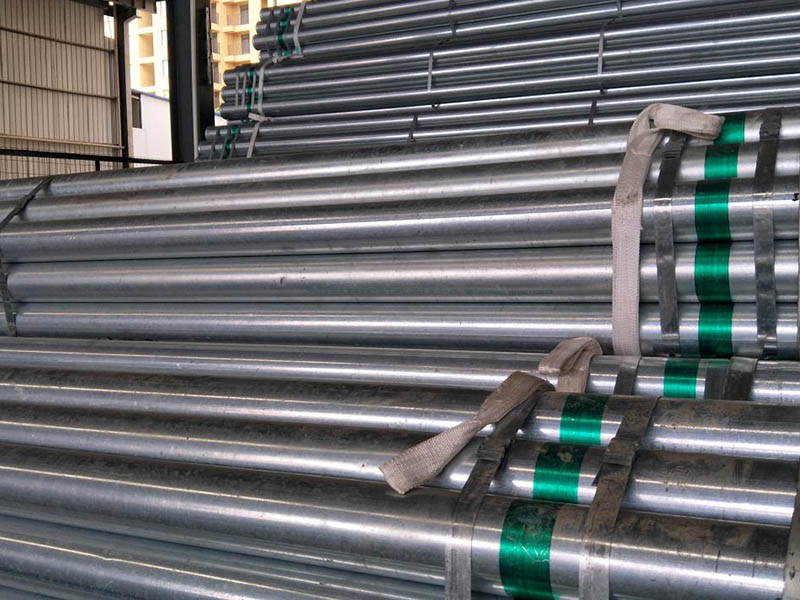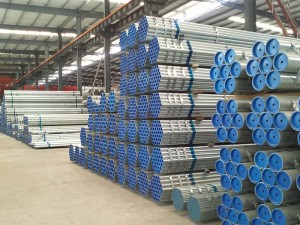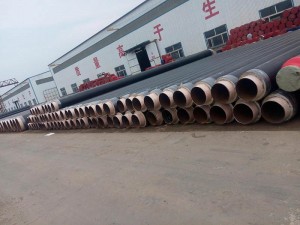Galvanized steel pipes are divided into cold-galvanized steel pipes and hot-dip galvanized steel pipes. Cold-galvanized steel pipes have been banned, and the latter is also advocated by the state to be used temporarily. In the 1960s and 1970s, developed countries in the world began to develop new types of pipes and gradually banned galvanized pipes. Four ministries and commissions including the Ministry of Construction of China also issued a document clarifying that galvanized pipes have been banned as water supply pipes since 2000. Galvanized pipes are rarely used for cold water pipes in newly built communities, and galvanized pipes are used for hot water pipes in some communities. Hot-dip galvanized steel pipes are widely used in fire fighting, electric power and highways. Hot-dip galvanized steel pipes are widely used in manufacturing industries such as construction, machinery, coal mines, chemicals, electric power, railway vehicles, automobile industry, highways, bridges, containers, sports facilities, agricultural machinery, petroleum machinery, prospecting machinery, greenhouse construction and other manufacturing industries.
Galvanized steel pipes are welded steel pipes with hot-dip galvanized or electro-galvanized layers on the surface. Galvanizing can increase the corrosion resistance of the steel pipe and prolong its service life. Galvanized pipe has a wide range of uses. In addition to line pipes for conveying water, gas, oil and other general low-pressure fluids, it is also used as oil well pipes and oil pipes in the petroleum industry, especially offshore oilfields, as well as oil heaters and condensate for chemical coking equipment. Pipes for coolers, coal-distilled wash oil exchangers, pipe piles for trestle bridges, pipes for support frames of mine tunnels, etc. The hot-dip galvanized pipe is to make the molten metal and the iron matrix react to produce an alloy layer, so that the matrix and the coating are combined. Hot-dip galvanizing is to pickle the steel pipe first. In order to remove the iron oxide on the surface of the steel pipe, after the pickling, it is cleaned in a tank of ammonium chloride or zinc chloride aqueous solution or a mixed aqueous solution of ammonium chloride and zinc chloride, and then sent to In the hot dip plating tank. Hot-dip galvanizing has the advantages of uniform coating, strong adhesion and long service life. The matrix of the hot-dip galvanized steel pipe undergoes a complex physical and chemical reaction with the molten plating solution to form a corrosion-resistant zinc-iron alloy layer with a compact structure. The alloy layer is integrated with the pure zinc layer and the steel pipe matrix, so its corrosion resistance is strong. Cold galvanized pipe is electro-galvanized, and the amount of galvanization is very small, only 10-50g/m2, and its corrosion resistance is much different than that of hot-dip galvanized pipe. Most of the regular galvanized pipe manufacturers do not use electro-galvanized (cold plating) in order to ensure the quality. Only those small enterprises with small scale and outdated equipment use electro-galvanization, and of course their prices are relatively cheaper. The Ministry of Construction has officially announced that cold-galvanized pipes with outdated technology should be eliminated, and cold-galvanized pipes are not allowed to be used as water and gas pipes. The galvanized layer of cold galvanized steel pipe is an electroplated layer, and the zinc layer is layered independently from the steel pipe matrix. The zinc layer is thin, and the zinc layer simply adheres to the steel pipe substrate and is easy to fall off. Therefore, its corrosion resistance is poor. In newly-built houses, it is forbidden to use cold galvanized steel pipes as water supply pipes.
Weight factor
Nominal wall thickness (mm): 2.0, 2.5, 2.8, 3.2, 3.5, 3.8, 4.0, 4.5.
Coefficient parameter (c): 1.064, 1.051, 1.045, 1.040, 1.036, 1.034, 1.032, 1.028.
Note: The mechanical properties of steel is an important index to ensure the final use performance (mechanical properties) of the steel, and it depends on the chemical composition of the steel and the heat treatment system. In the steel pipe standard, according to different application requirements, tensile properties (tensile strength, yield strength or yield point, elongation), hardness and toughness indexes are specified, as well as high and low temperature properties required by users.
Steel grades: Q215A; Q215B; Q235A; Q235B.
Test pressure value/Mpa: D10.2-168.3mm is 3Mpa; D177.8-323.9mm is 5Mpa.
The use of galvanized pipes. The iron pipes used for gas and heating are also galvanized pipes. Galvanized pipes are used as water pipes. After a few years of use, a large amount of rust and dirt will be generated in the pipes. The yellow water flowing out not only pollutes the sanitary ware, but also contains uneven inner walls. The breeding of bacteria and rust cause high levels of heavy metals in the water, which seriously endangers human health.
Production steps
The process flow is: black tube-alkaline washing-water washing-pickling-water rinsing-soaking aid-drying-hot dip galvanizing-external blowing-internal blowing-air cooling-water cooling -Passivation-water rinsing-inspection-weighing-storage.
skills requirement
1. Brand and chemical composition
The grade and chemical composition of the steel for galvanized steel pipes should comply with the grade and chemical composition of the steel for black pipes as specified in GB/T3091.
2. Manufacturing method
The manufacturing method of the black pipe (furnace welding or electric welding) is selected by the manufacturer. Hot-dip galvanizing is used for galvanizing.
3. Thread and pipe joints
(A) For galvanized steel pipes delivered with threads, the threads should be machined after galvanizing. The thread should comply with YB 822 regulations.
(B) Steel pipe joints should comply with YB 238; malleable cast iron pipe joints should comply with YB 230.
4. Mechanical properties The mechanical properties of steel pipes before galvanizing should meet the requirements of GB 3091.
5. The uniformity of the galvanized layer Galvanized steel pipe should be tested for the uniformity of the galvanized layer. The steel pipe sample shall not turn red (copper-plated color) after being immersed in copper sulfate solution for 5 consecutive times.
6. Cold bend test The galvanized steel pipe with a nominal diameter of not more than 50mm should be subjected to a cold bend test. The bending angle is 90°, and the bending radius is 8 times the outer diameter. There is no filler during the test, and the weld of the sample should be placed on the outside or upper part of the bending direction. After the test, there should be no cracks and peeling of the zinc layer on the sample.
7. Water pressure test The water pressure test should be carried out in the clarinet. Eddy current flaw detection can also be used instead of the water pressure test. The test pressure or the size of the comparison sample for eddy current testing shall meet the requirements of GB 3092. The mechanical properties of steel is an important index to ensure the final use performance (mechanical properties) of the steel.
Mechanical properties
① Tensile strength (σb): The maximum force (Fb) that the sample bears when it breaks during the tensile process, divided by the stress (σ) obtained by the original cross-sectional area (So) of the sample, is called the resistance Tensile strength (σb), the unit is N/mm2 (MPa). It represents the maximum ability of a metal material to resist damage under tensile force. In the formula: Fb-the maximum force that the sample bears when it is broken, N (Newton); So-the original cross-sectional area of the sample, mm2.
②Yield point (σs): For a metal material with a yield phenomenon, the stress at which the sample can continue to elong without increasing the force during the stretching process is called the yield point. If the force drops, the upper and lower yield points should be distinguished. The unit of yield point is N/mm2 (MPa). Upper Yield Point (σsu): The maximum stress before the specimen yields and the force drops for the first time; Lower Yield Point (σsl): The minimum stress in the yield stage when the initial transient effect is not taken into account. Where: Fs–yield force (constant) during the tensile process of the sample, N (Newton) So–the original cross-sectional area of the sample, mm2.
③ Elongation after break: (σ) In the tensile test, the percentage of the length of the gauge length increased by the specimen after it is broken to the original gauge length is called the elongation. Expressed by σ, the unit is %. In the formula: L1-the gauge length of the specimen after breaking, in mm; L0-the original gauge length of the specimen, in mm.
④ Reduction of area: (ψ) In the tensile test, the percentage of the maximum reduction of the cross-sectional area at the reduced diameter of the sample after the sample is broken to the original cross-sectional area is called the reduction of area. Expressed in ψ, the unit is %. In the formula: S0-the original cross-sectional area of the sample, mm2; S1-the minimum cross-sectional area at the reduced diameter of the sample after it is broken, mm2.
⑤Hardness index: The ability of metal materials to resist the indentation of hard objects on the surface is called hardness. According to different test methods and scope of application, hardness can be divided into Brinell hardness, Rockwell hardness, Vickers hardness, Shore hardness, micro hardness and high temperature hardness. There are three commonly used pipes: Brinell, Rockwell, and Vickers hardness.
Brinell Hardness (HB): Use a steel ball or cemented carbide ball of a certain diameter to press into the surface of the sample with the specified test force (F), remove the test force after the specified holding time, and measure the indentation diameter on the surface of the sample (L). The Brinell hardness value is the quotient obtained by dividing the test force by the spherical surface area of the indentation. Expressed in HBS (steel ball), the unit is N/mm2 (MPa).








